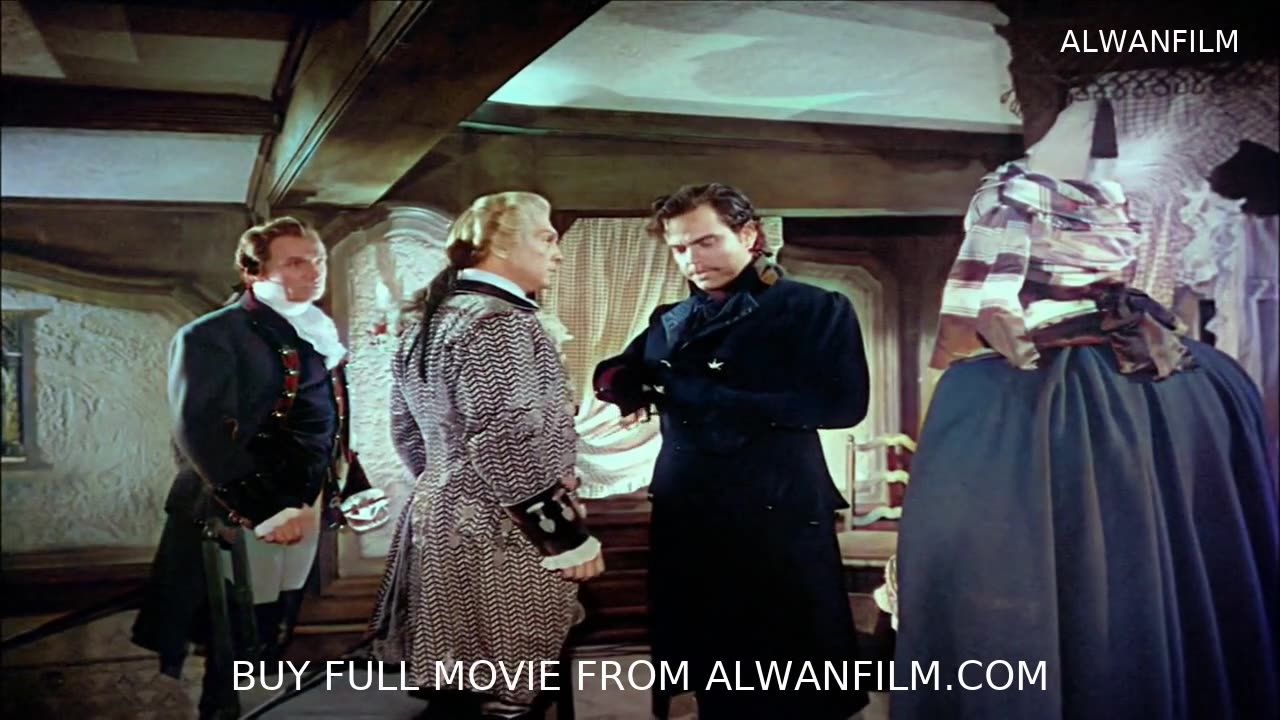Premium Only Content

Black Magic Colorized
Black Magic Colorized
Introduction
In the annals of cinematic history, few films captivate the imagination quite like "Black Magic 1949." Directed by the ingenious Gregory Ratoff, this film, inspired by the life of the notorious charlatan and magician Cagliostro, combines historical intrigue with supernatural elements. The film's re-release in an early colored version has reignited interest and debate among film enthusiasts and historians. This article delves into the significance of this colorized rendition, examining its impact on the narrative and its place in film history.
Check The Full Colorized Movies List
Check Our YouTube Channel
Check Our Colorized Movies Trailer Channel
Understanding Black Magic 1949 Colorized: Director, Cast, and Genre
"Black Magic 1949" is a product of the creative vision of Gregory Ratoff, a multifaceted talent known for his work as an actor, producer, and director. The film stars the charismatic Orson Welles as the enigmatic Cagliostro, supported by an impressive cast including Nancy Guild, Akim Tamiroff, and Valentina Cortese. Set in 18th-century Europe, the film weaves a tale of mystery, deception, and magic, firmly rooting itself in the historical drama genre with a touch of the supernatural.
Ratoff's direction imbues the film with a sense of grandeur and mystique, capturing the opulence and intrigue of the period. Welles' portrayal of Cagliostro is both mesmerizing and unsettling, bringing to life a character shrouded in myth and controversy. The film's genre blend of historical drama and supernatural thriller creates a captivating cinematic experience.
Exploring the World of Black Magic 1949 Colorized: Plot and Characters
The plot of "Black Magic 1949" centers on the life and exploits of Cagliostro, a man who rises from humble beginnings to become a powerful and feared figure in European high society. The film traces his journey from a young orphan with extraordinary hypnotic abilities to a master manipulator who wields his influence over kings and commoners alike.
Central to the narrative is Cagliostro's quest for power and revenge. His path intersects with various historical figures and events, adding layers of complexity to the story. The supporting characters, from his loyal accomplice Gilbert (Akim Tamiroff) to the virtuous Lorenza (Nancy Guild), each play pivotal roles in the unfolding drama. The film masterfully balances moments of tension, intrigue, and dark humor, creating a rich tapestry of storytelling.
The Art of Film Colorization
Film colorization, the technique of adding color to black and white footage, has been both celebrated and criticized since its inception. Proponents argue that it brings new life to classic films, making them more accessible to modern audiences. Critics, however, contend that it can undermine the original artistic intent and historical context of the work.
The process of colorization involves meticulous attention to detail, ensuring that the added colors enhance rather than detract from the film's visual integrity. Advances in technology have made colorization more sophisticated, allowing for greater accuracy and subtlety in recreating the original scenes' ambiance.
Early Colored Films: A Brief History
The journey of color in cinema began with early experiments in hand-coloring and tinting, gradually evolving into more advanced techniques like Technicolor. These innovations marked significant milestones in film history, offering filmmakers new tools to enhance storytelling and visual appeal.
Early colored films provided audiences with vibrant and immersive experiences, transforming the way stories were told on screen. From the hand-painted frames of Georges Méliès' fantasies to the rich palettes of Technicolor epics, the evolution of color in cinema reflected the industry's relentless pursuit of artistic and technological advancement.
Black Magic 1949 and Its Early Colored Version
The decision to release "Black Magic 1949" in an early colored version introduces a fresh perspective on this classic film. While some may view the colorization as a departure from the original black and white aesthetic, it undeniably offers new insights and visual dynamics to the narrative.
The colorized version accentuates the film's lavish settings and period details, bringing to life the opulence of 18th-century Europe. The vibrant hues add depth to the characters and scenes, highlighting the contrast between Cagliostro's dark machinations and the splendor of the world he seeks to control.
The Debate Over Film Colorization
The colorization of classic films like "Black Magic 1949" continues to spark debate among cinephiles and scholars. Supporters argue that it revitalizes aging films, making them more appealing to contemporary viewers. Critics, however, fear that it may compromise the director's original vision and the film's historical authenticity.
This debate touches on broader issues of preservation and interpretation in cinema. While colorization can enhance accessibility and visual appeal, it also raises questions about artistic integrity and the balance between innovation and tradition. As technology evolves, the discourse around film colorization will likely continue to evolve as well.
Examining Black Magic 1949 as an Early Colored Film
Viewing "Black Magic 1949" in its colorized form offers a unique lens through which to appreciate the film's artistry and narrative. The addition of color brings out nuances in the production design, costumes, and cinematography that may be less noticeable in black and white.
The colorized version enhances the film's visual storytelling, emphasizing the contrast between light and shadow, opulence and decay. It provides a new dimension to the characters and settings, enriching the audience's engagement with the story. However, it also invites critical reflection on how colorization alters the film's original mood and atmosphere.
Influence and Legacy: Black Magic 1949 Colorized's Impact on Cinema
"Black Magic 1949" has left a lasting imprint on cinema, influencing subsequent films and filmmakers with its blend of historical drama and supernatural elements. Orson Welles' portrayal of Cagliostro remains a highlight of his illustrious career, showcasing his ability to embody complex and charismatic characters.
The film's innovative approach to storytelling and its exploration of themes like power, deception, and redemption resonate with contemporary audiences and filmmakers. Its legacy is evident in the continued fascination with historical figures and events, as well as the enduring appeal of supernatural thrillers.
Director's Cinematic Legacy: Beyond Black Magic 1949 Colorized
Gregory Ratoff's contributions to cinema extend beyond "Black Magic 1949," encompassing a diverse body of work that spans acting, producing, and directing. His ability to navigate different genres and styles reflects his versatility and creative vision.
Ratoff's influence on Hollywood and international cinema is significant, with his films often exploring themes of ambition, identity, and resilience. His collaboration with talented actors and writers has resulted in a rich and varied filmography that continues to inspire and entertain audiences.
Themes Explored in Black Magic 1949 Colorized
"Black Magic 1949" delves into themes of power, manipulation, and the blurred lines between reality and illusion. Cagliostro's rise to power is driven by his ability to exploit people's fears and desires, highlighting the darker aspects of human nature.
The film also explores the concept of redemption, as Cagliostro's journey is marked by moments of introspection and moral conflict. His relationships with other characters, particularly Lorenza, serve as a mirror to his own struggles with identity and purpose. The interplay between light and dark, truth and deception, forms the thematic core of the narrative.
Reception and Controversy Surrounding Black Magic 1949 Colorized
The colorized re-release of "Black Magic 1949" has garnered mixed reactions from critics and audiences. While some praise the enhanced visual experience, others argue that it detracts from the film's original charm and historical context.
Critics have noted the film's strengths in storytelling, performance, and production design, with particular emphasis on Welles' captivating portrayal of Cagliostro. However, the colorization process has sparked controversy, with some purists questioning its impact on the film's artistic integrity.
Where to Watch Black Magic 1949 Colorized Online
For those eager to experience "Black Magic 1949," the film is available on various streaming platforms, providing access to both the original black and white version and the early colored rendition. This accessibility allows viewers to appreciate the film in different contexts and form their own opinions about the colorization process.
FAQs About Black Magic 1949 Colorized
Common queries about "Black Magic 1949" often revolve around its historical accuracy, thematic depth, and the impact of colorization. Addressing these frequently asked questions can enhance viewers' understanding and appreciation of the film.
Q: How historically accurate is "Black Magic 1949"?
A: While the film draws inspiration from the life of Cagliostro, it takes creative liberties with historical events and characters. The focus is on capturing the essence of his persona and the period's atmosphere rather than strict historical accuracy.
Q: What are the main themes explored in the film?
A: The film explores themes of power, deception, redemption, and the interplay between reality and illusion. Cagliostro's manipulation of others and his internal moral conflicts form the crux of the narrative.
Q: How does the colorized version differ from the original?
A: The colorized version adds a new visual dimension to the film, highlighting details in production design and costumes. However, it also alters the original mood and aesthetic, sparking debate about artistic integrity.
Conclusion
In conclusion, "Black Magic 1949" stands as a testament to the enduring power of cinema to captivate and provoke thought. The early colored version offers a fresh perspective on this classic film, inviting viewers to re-examine its themes and visual storytelling. While the debate over colorization continues, the film's impact and legacy remain undiminished, reflecting the timeless allure of its narrative and characters. As we navigate the evolving landscape of film preservation and innovation, "Black Magic 1949" serves as a reminder of the delicate balance between honoring artistic intent and embracing new possibilities in cinematic expression.
-
 1:00
1:00
AlwanFilm
9 days agoThe Red Head 1932 Colorized
21 -
 LIVE
LIVE
Barry Cunningham
1 hour agoWATCH LIVE: PRESIDENT TRUMP SPEECH ON INVESTING IN AMERICA!
523 watching -
 LIVE
LIVE
Dr Disrespect
5 hours ago🔴LIVE - DR DISRESPECT - WARZONE NUKE - WILL IT EXPLODE?
2,865 watching -

Darkhorse Podcast
3 hours agoThe 274th Evolutionary Lens with Bret Weinstein and Heather Heying
21.4K19 -
 DVR
DVR
Iggy Azalea
55 minutes agoplaying motherland
2.54K -
 LIVE
LIVE
StoneMountain64
3 hours ago1st stream BACK! Arc Raiders BRAND new exclusive alpha early look
321 watching -
 2:12:09
2:12:09
The Quartering
4 hours agoUkraine Mineral Deal Today, China Suffering From Tariffs, Epstein Suicide Letter, Meme Ban!
73K36 -
 1:17:36
1:17:36
The White House
3 hours agoPress Secretary Karoline Leavitt Briefs Members of the New Media, Apr. 30, 2025
49.2K23 -
 LIVE
LIVE
RiftTV/Slightly Offensive
2 hours agoWitnessing The COMPLETE COLLAPSE of American Society | Guests: Gavin McInnes and Anthony Cumia
826 watching -
 LIVE
LIVE
The HotSeat
1 hour agoBuffalo Schools PROTECTED PREDATORS – Angry Cops Exposes Child Abuse Cover-Up from Hell!
566 watching